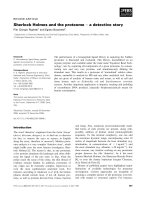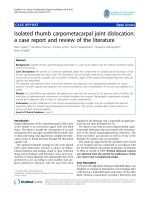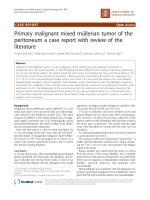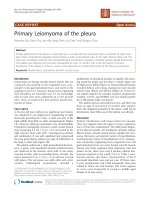báo cáo khoa học: "Primary sarcoma of the pancreas, a rare histopathological entity. A case report with review of literature" pps
Bạn đang xem bản rút gọn của tài liệu. Xem và tải ngay bản đầy đủ của tài liệu tại đây (2.41 MB, 4 trang )
CAS E REP O R T Open Access
Primary sarcoma of the pancreas, a rare
histopathological entity. A case report with
review of literature
Peter Ambe
1*
, Christian Kautz
2
, Shawqi Shadouh
3
, Silvia Heggemann
4
and Lothar Köhler
1
Abstract
Aims: primary pancreatic sarcomas represent an extremely rare histopathologica l entity accounting for less than
0.1% of all pancreatic malignancies. Pancreatic sarcomas tend to be more aggressive and have a poor prognosis.
Methods: the case of a 52 year old patient presenting with jaundice is presented and the available literature was
reviewed.
Results: primary pancreatic sarcomas are extremely rare. Pancreatic sarcomas are more aggressive than other
pancreatic neoplasms.
Conclusion: primary sarcomas of the pancreas are extremely rare, are aggressive and are associated with very poor
prognosis.
Background
Sarcomas represent a relatively rare malignant entity.
Primary sarcomas of the pancreas are even rarer.
Amongst pancreatic sarcomas, leiomyosa rcomas have
been most commonly reported. A review of the liter a-
ture reveals seven cases of ca rcinosarcoma. We report a
case of epitheloid carcinosarcoma in a young male
patient presenting with pancreatitis and jaundice.
Case presentation
A 52 year old male with a history of chronic alcohol
consumption was ad mitted in the medical department
of our community hospital with an acute onset of upper
abdominal pain, nausea and vomiting. The diagnostic
workup reveal ed elevated amylase and lipase of 1012U/l
and 1160U/ l respectively. A swollen edemato us pancreas
caput and gallbladder stones were evident on upper
abdominal ultrasound. At the time of admission, an
endoscopic retrograde cholangio-pancreaticography
(ERCP ) was performed. The common bile duct however
could not be visualized. ERCP was repeated after three
days with papillotomy. A narrow common bile d uct
without stones or stenosis was visualized [Figure 1].
The patient recovered fully and was discharged after
8 days. One month after discharge the patient was read-
mitted with right upper quadrant pain and jaundice.
The routine workup revealed elevated liver enzymes and
bilirubin (total bilirubin: 10.78 mg/dl, direct bilirubin
9.86 mg/dl, indirect bilirubin:0.92 mg/dl, alkaline phos-
phatase: 337.64U/l). Cholecystitis was evident on upper
abdominal sonography. Choledocholithiasis was presen t
on ERCP, papillotomy and stone extraction were
uneventful. Cholecystectomy was indicated.
Laparoscopic cholecystectomy was performed. During
laparoscopy the main bile duct appeared unusally wide
even after papillotomy and stone extraction, thus an
intraoperative cholangiography was performed. This
revealed a significant stenosis in the distal end of the cho-
ledochus. The proximal bile duct branches were dilated
(Figure 2). An ERCP on day t wo after c holecystectomy
showed a 2 × 3 cm measuring ulceration above the
papilla of Vateri [ Figure 3]. Biopsies revealed an ulcerat-
ing malignoma with duodenal infiltration. A stent was
placed in the common bile duct. A CT scan of the abdo-
men revealed a large process of the pancreatic head with-
out signs of mesenteric vessels infiltration [Figure 4].
* Correspondence:
1
Department of Surgery, St. Elisabeth Kreiskrankenhaus Grevenbroich,
Akademisches Lehrkrankenhaus der RWTH Aachen, Germany
Full list of author information is available at the end of the article
Ambe et al. World Journal of Surgical Oncology 2011, 9:85
/>WORLD JOURNAL OF
SURGICAL ONCOLOGY
© 2011 Ambe et al; licensee BioM ed Central Ltd. This is an Open Access article distributed under the terms of the Creative Commons
Attribution License ( which permits unrestricted use, distribution, and reproduction in
any medium, provided the original work is properly cited.
On laparotomy a large tumor of the pancreatic caput
enclosing the superior mesenteric and hepatic arteries with
mesenterial infiltration was identified, making a complete
resection unlikely. The tumor was left in situ and trans-
duodenal biopsies were taken for histopathology. Wi th a
choledochus stent in place, a biliodigestive anastomosis was
not indicated. To prevent future bowel obstruction, a gas-
troenteric anastomosis was constructed using small bowel
40 cm distal to the ligament of Treitz. The postoperative
recovery was uneventful. A venous port system was
implanted 10 days after laparotomy. The patient was dis-
charged to our out-patient oncology. Chemotherapy with
Gencitabine, 5-Fluorouracil and Folinic acid was initiated.
Histopathology
Histologic sections revealed large neoplastic cells
with epitheloid and sarcomatoid differentiation.
Immunhistochemical staining demonstrated a co-
expression of cytokeratin and vimentin. Stains for Cal-
desmon, CD 34, CD 31 and S100 were negative. A
pure sarcoma or melanoma could be excluded on
immunhistochemistry [Figure 5 A-C].
Discussion
Sarcoma s of the pancreas are exceedingly rare. Baylor et
al reported a 0.1% incidence of pancreati c sarcoma after
review 5000 cases of pancreatic cancer [1]. Amongst
pancreatic sarcomas leiomyosarcomas tend to occur
relatively frequent [2]. Epitheloid sarcomas also known
as carcinosarcomas represent an even rarer subgroup
with very few reported cases in the english literature.
Darvishian and colleagues reported t he 7
th
case in the
English literature [3]. Thus the incidence of carcinosar-
coma as a single entity is expected to be far below 0.1%.
Figure 1 ERCP at the initial presentation. (nor mal common bile
duct on ERCP at the initial presentation).
Figure 2 Intraoperative Cholangiogramm. (The thin arrow points
at the stenosis, while the thick arrow demonstrates central dilated
bile duct system).
Figure 3 Duodenal ulceration on ERCP. (the arrow points at a 2
× 3 cm ulceration in the duodenum on ERCP).
Figure 4 Ct scan of the pancreas. (The arrow marks the enlarged
pancreatic caput).
Ambe et al. World Journal of Surgical Oncology 2011, 9:85
/>Page 2 of 4
According to Feather et al sarcomas of the pancreas
occur frequently in younger individuals. The pancreatic
caput is most commonly involved f ollowed by the tail
and the body [4]. These features tend to correspond
with those in the case presented. T he patient, 52 years
of age, relatively young, was diagnosed with a sarcoma
of the pancreatic caput.
Clinically patients present with colicky pain, nausea
and vomiting. These findings are basically similar to
those of other pancreatic pathologies and are thus
unspecific to sarcomas. Gray and many others consider
a painless jaundice as a sign of an advanced lesion [5].
This was true for the case presented.
The diagnosis of pancreatic pathologies is usually con-
firmed using imaging techniques like ultrasound, com-
puted tomography (Ct), magnetic resonance imaging
(MRI), endoscopic retrograde cholangiopancreaticogrphy
(ERCP) [6-8].
On initial presentation abdominal ultrasound and
ERCP were not suspicious of a pancreatic malignancy as
seen in figure 1. A pancreatic proces s was suspected on
an intraoperative cholangiogramm as seen in figure 2.
This was later confirmed on CT and ERCP. To what
extend an early ct scan would have confirmed a malig-
nancy remains unclear.
Surgical resection is the only possible cure for pan-
creatic malignancies. Radical resections are done for
localized lesions. Advanced lesions warrant palliation.
Potts et al proved the importance of a palliative gastric
bypass in advanced stages [9].
In this case, the patient presented with an advanced
tumor, so curative resection was not feasible. A pallia-
tive gastroenteric anast omosis was d one. The co mmon
bile duct was not revised since a stent was placed during
ERCP [10]. A venous port system was implanted and the
patient was sent in for chemotherapy.
Pancreatic cancers generally have a poor prognosis
since they tend t o be d iagnosed in an advance d stage.
Sarcomas of the pancreas tend to grow much more
rapidly and are believed to be associated with an even
worse prognosis [4].
Inthecasepresented,thesarcomacouldhavegrown
within three month, i.e between initial presentation in
November 2010 and diagnosis in January 2011. This
would support the notion that sarcomas tend to grow
rapidly. The patient was discharged from the surgical
department in a good shape and chemotherapy with
Gencitabine, 5- FU and folinic acid was initiated.
Conclusion
Primary sarcomas of the pancreas are extremely rare.
Although little is known about pancreatic sarcomas,
they appear to be more aggressive and are associated
with a worse prognosis.
Consent
Written informed consent was obtained from the patient
for publication of this case report and accompanying
images. A copy of the written consent is available for
review by the Editor-in-Chief of this journal
Author details
1
Department of Surgery, St. Elisabeth Kreiskrankenhaus Grevenbroich,
Akademisches Lehrkrankenhaus der RWTH Aachen, Germany.
2
Department
of internal medicine and oncology, St. Elisabeth Kreiskrankenhaus
Grevenbroich, Germany.
3
Institute of Pathology, St. Elisabeth
Kreiskrankenhaus Grevenbroich, Germany.
4
Medical Faculty, RWTH - Aachen,
Germany.
Figure 5 Histol ogical slides. (HE, Cyt okeratin and vemintin stains
showing tumor cells with little or no pancreatic tissue).
Ambe et al. World Journal of Surgical Oncology 2011, 9:85
/>Page 3 of 4
Authors’ contributions
PA, CK and SH did the literature research, PA wrote the article, SS did the
pathology, LK edited the article. All the authors reviewed and approved the
end version
Conflicts of interests statment
Drs. Ambe, Kautz, Shadouh, Köhler and cand med. Heggemann have no
conflicts of interest or financial ties to disclose.
Received: 5 April 2011 Accepted: 3 August 2011
Published: 3 August 2011
References
1. Baylor SM, Berg JW: Cross classification and survival characteristics of
5000 cases of cancer of the pancreas. J Surg Oncol 1973, 5 :335-358.
2. Zhang H, Jensen MH, Farnell MB, Smyrk TC, Zhang L: Primary
Leiomyosarcoma of the Pancreas: Study of 9 Cases and Review of
Literature. Am J Surg Pathol 2010, 34:1849-1856.
3. Darvishian F, Sullivan J, Teichberg S, Basham : Carcinosarcoma of the
pancreas. Arch Pathol Lab Med 2002, 126:1114-17.
4. Feather HE, Kuhn CL: Total pancreatectomy for sarcoma of the pancreas.
Ann Surg 1951, 134(5):904-912.
5. Howard KGray: Carcinoma of the pancreas. Arch Surg 1948, 57(6):763-773.
6. Karlson BM, Ekbom A, Lindgren PG, Kalskogg V, Rastad J: Abdominal US for
diagnosis of pancreatic tumor: prospective cohort analysis. Radiology
1999, 213:107-111.
7. Sheridan MB, Ward J, Guthrie JA, Spencer JA, Craven CM, Wilson D,
Guillou PJ, Robinson PJ: Dynamic contrast-enhanced MR imaging and
dual-phase helical CT in the preoperative assessment of suspected
pancreatic cancer: a comparative study with receiver operating
characteristic analysis. AJR Am J Roentgenol 1999, 173:583-590.
8. Adamek HE, Albert J, Breer H, Weitz M, Schilling D, Riemann JF: Pancreatic
cancer detection with magnetic resonance cholangiopancreatography
and endoscopic retrograde cholangiopancreatography: a prospective
controlled study. Lancet 2000, 356:190-193.
9. Potts JR, Broughan TA, Hermann RE: Palliative operations for pancreatic
carcinoma. Am J Surg 1990, 159(1):72-78.
10. Goya VRaikar, Matthew MMelin, Ress Andrew, Sara ZLettieri,
John JPoterucha, David M, Nagorney und John HDonohue: Cost-effective
analysis of surgical palliation versus endoscopic stenting in the
management of unresectable pancreatic cancer. Ann Surg Oncol 1995,
3(5):470-475.
doi:10.1186/1477-7819-9-85
Cite this article as: Ambe et al.: Primary sarcoma of the pancreas, a rare
histopathological entity. A case report with review of literature. World
Journal of Surgical Oncology 2011 9:85.
Submit your next manuscript to BioMed Central
and take full advantage of:
• Convenient online submission
• Thorough peer review
• No space constraints or color figure charges
• Immediate publication on acceptance
• Inclusion in PubMed, CAS, Scopus and Google Scholar
• Research which is freely available for redistribution
Submit your manuscript at
www.biomedcentral.com/submit
Ambe et al. World Journal of Surgical Oncology 2011, 9:85
/>Page 4 of 4









